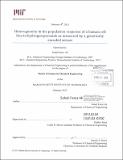| dc.contributor.advisor | Hadley Sikes. | en_US |
| dc.contributor.author | Ali, Sohail Feroz | en_US |
| dc.contributor.other | Massachusetts Institute of Technology. Department of Chemical Engineering. | en_US |
| dc.date.accessioned | 2013-06-17T19:56:13Z | |
| dc.date.available | 2013-06-17T19:56:13Z | |
| dc.date.copyright | 2013 | en_US |
| dc.date.issued | 2013 | en_US |
| dc.identifier.uri | http://hdl.handle.net/1721.1/79323 | |
| dc.description | Thesis (S.M.)--Massachusetts Institute of Technology, Dept. of Chemical Engineering, 2013. | en_US |
| dc.description | Cataloged from PDF version of thesis. | en_US |
| dc.description | Includes bibliographical references (p. 22-26). | en_US |
| dc.description.abstract | Genetically encoded ratiometric sensors can provide valuable mechanistic understanding of biological systems. Characterization of cellular response of these sensors is the first step in validating their use. Here, we characterize the response of a genetically encoded H₂O₂ sensor, HyPer, expressed in HeLa cells. Using quantitative fluorescence microscopy, we found significant heterogeneity in HyPer response among the cell population. Further analysis showed that the variation in HyPer response was dependent on expression of HyPer protein as well as on cell cycle phase. Cells with higher levels of expressed HyPer protein showed a stronger HyPer response to H₂O₂. Cells synchronized in S-phase showed a weaker HyPer response than unsynchronized cells. It was determined that this weaker response could be a function of higher antioxidant capacity in S-phase cells. The dependence of HyPer response on these factors needs to be accounted for to avoid experimental artifacts. | en_US |
| dc.description.statementofresponsibility | by Sohail Feroz Ali. | en_US |
| dc.format.extent | 26 p. | en_US |
| dc.language.iso | eng | en_US |
| dc.publisher | Massachusetts Institute of Technology | en_US |
| dc.rights | M.I.T. theses are protected by
copyright. They may be viewed from this source for any purpose, but
reproduction or distribution in any format is prohibited without written
permission. See provided URL for inquiries about permission. | en_US |
| dc.rights.uri | http://dspace.mit.edu/handle/1721.1/7582 | en_US |
| dc.subject | Chemical Engineering. | en_US |
| dc.title | Heterogeneity in the population response of a human cell line to hydrogen peroxide as measured by a genetically encoded sensor | en_US |
| dc.type | Thesis | en_US |
| dc.description.degree | S.M. | en_US |
| dc.contributor.department | Massachusetts Institute of Technology. Department of Chemical Engineering | |
| dc.identifier.oclc | 844752735 | en_US |

